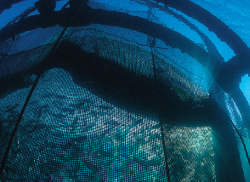
Aquaculture production in Kenya has grown steadily in recent years to more than 18,000 tonnes in 2019 and plays an increasingly important role in national fish supply.
Kenya is ranked the fourth in aquaculture in Africa and endowed with a vast network of aquatic resources comprising freshwater lakes and rivers, and an extensive ocean resource base.
The fisheries and aquaculture sector contributes about 0.8 per cent to the Gross Domestic Product (GDP), providing direct employment to over 500,000 people and supporting over two million people indirectly.
Current annual demand for fish feed in Kenya is estimated at 34,000 tonnes. However, has far greater capacity for fish farming, with over 1.14 million hectares potentially available with potential a production capacity of over 11 million tonnes per year.
The Blue Economy
The Blue Economy in Kenya represents a huge opportunity and potential to achieve economic growth and generate jobs.
The concept recognizes productivity of healthy freshwater and ocean ecosystems as a pathway for freshwater aquatic and maritime-based economies, and promotes the conservation, sustainable use, and management of associated marine resources.
In aquaculture, the approaches for actualising the aspirations embodied in the Blue Economy concept include: Cage culture (Ocean, Lakes, Dams, and Rivers); Integrated RAS; Aquaponics/Greenhouse; Pens; breeding and restocking of commercially important indigenous species; and live fish markets
Fish Feeds
Due to the growing demand for fish and fish products, there has been a gradual shift from extensive to moderately intensive aquaculture systems, leading to an increased demand for high quality commercial fish feeds.
The Government through the Kenya Marine Fisheries Institute (KMFRI) has developed fish feed standards in partnership with the Kenya Bureau of Standards (KEBS) to serve a market whose demand is estimated at 7,000 tonnes annually.
Kenya has fast growing fish species (Nile tilapia, African catfish), extensive freshwater resources suitable for the cage, pond and tank-based aquaculture systems and its agriculture and fisheries sectors produce enough raw materials for making fish feed.
Kenya also has a highly developed fish processing sector and quality assurance laboratories. Highest pond numbers and aquaculture related activities are found in Kakamega, Bungoma, Busia, Kisii, Meru, Nyeri, Kisumu, Muranga, Embu counties, among others, while relatively lower activity are noted in Kitui, Lamu and Elgeyo Marakwet.
The main cultured species in Kenya’s freshwater systems are Nile tilapia which accounts for 80 per cent of production, followed by African cat- fish (14 per cent). These species are found in virtually all aquatic systems and have high demand in the local and regional markets.
Polyculture of Nile tilapia and African catfish is often done to control the prolific breeding of the former.
Other exotic species include common carp (4 per cent), rainbow trout (2 per cent), koi carp, largemouth bass and goldfish.
Trout is temperature restricted thus only cultured at temperatures below 19°C mainly in the Mt. Kenya region. Potential indigenous candidates for aquaculture include African Carps, Lungfish and Tilapia jipe.
There are great opportunities in ornamental fish culture for they can be marketed within the East African region and in Europe.
Mariculture Species
The most farmed finfish species is milkfish, which accounts for about 90 per cent of production, followed by mullet contributing about 10 per cent of aquaculture production.
Juveniles of these species are found in the mangrove systems and are in high demand. Shellfish culture in coastal Kenya involves mud crabs, prawns, and artemia.
Regulatory interventions Legislation is underway to support projects geared at pushing annual out- put to at least 300,000 metric tonnes of fish worth Sh100 billion annually.
The Ministry of Agriculture, Livestock and Fisheries Development has developed a raft of policy, regulatory and financing incentives to accelerate transformation of the fisheries sector
Among them is the Draft Marine Fisheries Access Regulations 2021 to support local exploitation Kenya’s 200 nautical miles Exclusive Economic Zone (EEZ). The regulations will address unregulated fishing and transshipment of stock outside the country.
They will operationalise the Fishing Management and Development Act 2016, providing clarity on joint ventures between foreign investors and Kenyans at international, national or written agreements on fisheries access.
They will also address some of the challenges facing Kenyan fishermen and seal loopholes used by foreign fishing vessels use to exploit the country’s rich marine resources. Efforts to transform this sub-sector have gained steam to boost food security, exports and rural livelihoods.
The Kenya Fisheries Industries Corporation and the Liwatoni Fishing Port has been gazetted. Efforts are also ongoing to improve local strain of tilapia, refurbish four fish landing sites in the coastal region, construct fish quality control laboratories and national aquaculture resource centre.
Aquaculture Value Chain
The Kenya Marine and Fisheries Research Institute (KMFRI) has developed new products to improve fish value chain in the country.
The products which include minced fish, fish samosa, fish sausages, fish fingers, fish gel, smoked fish and fish fillets are being introduced to farmers as a way to add value to their fish.
They were developed in collaboration with KMFRI’s research partners to pro- mote fish farming as an income generating venture and boost production.
Through the Kenya Climate Smart Agriculture Project (KCSAP) run jointly by KMFRI and KALRO, the new products are being rolled out to farmers in Siaya, Busia, Kakamega, Lamu and Marsabit Counties. Also developed by KMFRI is a modern fish smoking kiln.
Collaboration with Maseno Univerity, Egerton University, Jomo Kenyatta University of Agriculture and Technology and University of Eldoret has led to development of new products for fish farmers.
For instance, KMFRI has partnered with JKUAT to produce insect-based feeds which are nutritious for fish and will ensure that farmers get higher yields. KMFRI is also supplying fish farmers with high quality breeds and fingerlings.
